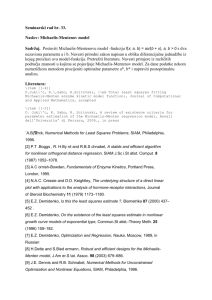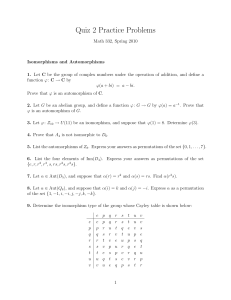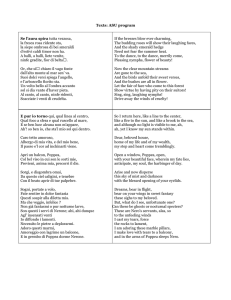Approximation of Amoebas and Coamoebas by Sums of Squares Definition: SDPs
advertisement
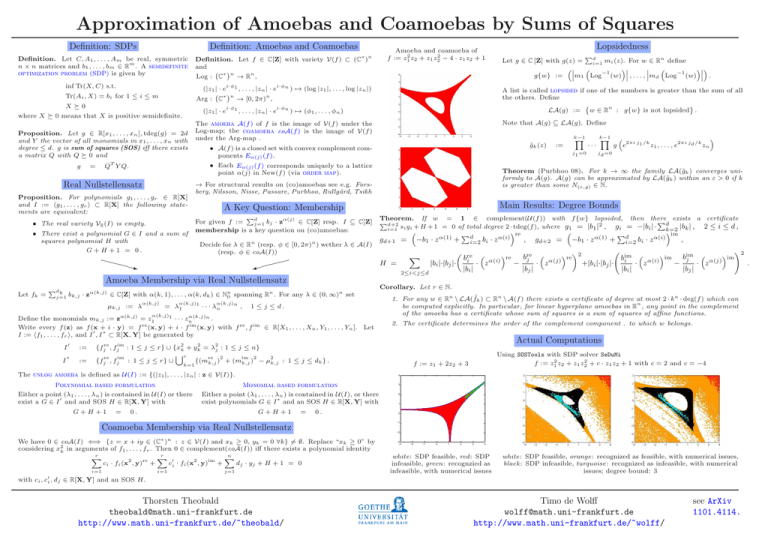
Approximation of Amoebas and Coamoebas by Sums of Squares
Definition: SDPs
Definition: Amoebas and Coamoebas
Definition. Let C, A1 , . . . , Am be real, symmetric
n × n matrices and b1 , . . . , bm ∈ Rm . A semidefinite
optimization problem (SDP) is given by
Definition. Let f ∈ C[Z] with variety V(f ) ⊂ (C∗ )n
and
Log : C∗ n → Rn ,
inf Tr(X, C) s.t.
i·φ1
(|z1 | · e
Tr(Ai , X) = bi for 1 ≤ i ≤ m
Arg : C∗
X 0
Proposition. Let g ∈ R[x1 , . . . , xn ], tdeg(g) = 2d
and Y the vector of all monomials in x1 , . . . , xn with
degree ≤ d. g is sum of squares (SOS) iff there exists
a matrix Q with Q 0 and
) 7→ (log |z1 |, . . . , log |zn |)
• The real variety VR (I) is empty.
For given f :=
∈ C[Z] resp. I ⊆ C[Z]
j=1 bj · z
membership is a key question on (co)amoebas:
Decide for λ ∈ Rn (resp. φ ∈ [0, 2π)n ) wether λ ∈ A(I)
(resp. φ ∈ coA(I))
XX
XX
9
z
Amoeba Membership via Real Nullstellensatz
Pdk
j=1
α(k,j)
µk,j := λ
α(k,j)1
= λ1
α(k,j)n
· · · λn
,
α(k,j)
1 · · · z α(k,j)n .
Define the monomials mk,j := zα(k,j) = z1
n
Write every f (z) as f (x + i · y) = f re (x, y) + i · f im (x, y) with f re , f im ∈ R[X1 , . . . , Xn , Y1 , . . . , Yn ]. Let
′
∗
I := hf1 , . . . , fr i, and I , I ⊂ R[X, Y] be generated by
I
re
im
re
im
′
:=
{fj , fj
∗
:=
{fj , fj
I
2
2
=
re
P
−b1 · z α(1) + di=2 bi · z α(i)
,
X
G+H +1
=
0.
We have 0 ∈ coA(I) ⇐⇒ {z = x + iy ∈ (C∗ )n : z ∈ V(I) and xk ≥ 0, yk = 0 ∀k} 6= ∅. Replace “xk ≥ 0” by
considering x2k in arguments of f1 , . . . , fr . Then 0 ∈ complement(coA(I)) iff there exists a polynomial identity
r
r
n
X
X
X
ci · fi (x2 , y)re +
c′i · fi (x2 , y)im +
d j · yj + H + 1 = 0
i=1
jd =0
gd+2 =
im
P
−b1 · z α(1) + di=2 bi · z α(i)
,
re
re 2
im
im
bre
bim
bre
bim j
j
i
· z α(i)
−
· z α(j)
−
· z α(j)
+|bi |·|bj |· i · z α(i)
|bi |
|bj |
|bi |
|bj |
!2
1. For any w ∈ Rn \ LA(f˜k ) ⊂ Rn \ A(f ) there exists a certificate of degree at most 2 · kn · deg(f ) which can
be computed explicitly. In particular, for linear hyperplane amoebas in Rn , any point in the complement
of the amoeba has a certificate whose sum of squares is a sum of squares of affine functions.
2. The certificate determines the order of the complement component . to which w belongs.
Actual Computations
Using SOSTools with SDP solver SeDuMi
f := z12 z2 + z1 z22 + c · z1 z2 + 1 with c = 2 and c = −4
f := z1 + 2z2 + 3
4
Monomial based formulation
Either a point (λ1 , . . . , λn ) is contained in U (I), or there
exist polynomials G ∈ I ∗ and an SOS H ∈ R[X, Y] with
Coamoeba Membership via Real Nullstellensatz
i=1
|bi |·|bj |·
2
0.
g e2πi j1 /k z1 , . . . , e2πi jd /k zn
Corollary. Let r ∈ N.
k=1
Polynomial based formulation
Either a point (λ1 , . . . , λn ) is contained in U (I) or there
exist a G ∈ I ′ and and SOS H ∈ R[X, Y] with
G+H +1
gd+1 =
: 1 ≤ j ≤ r} ∪ {xk + yk = λj : 1 ≤ j ≤ n}
[r
re 2
im 2
2
: 1 ≤ j ≤ r} ∪
{(mk,j ) + (mk,j ) − µk,j : 1 ≤ j ≤ dk } .
The unlog amoeba is defined as U (I) := {(|z1 |, . . . , |zn | : z ∈ V(I)}.
k−1
Y
Main Results: Degree Bounds
2≤i<j≤d
1 ≤ j ≤ d.
···
Theorem. If w = 1 ∈ complement(U (f )) with f {w} lopsided, then there
P exists a certificate
Pd+2
2
gi = −|bi | · dk=2 |bk | , 2 ≤ i ≤ d ,
i=1 si gi + H + 1 = 0 of total degree 2 · tdeg(f ), where g1 = |b1 | ,
H =
n
n
bk,j · zα(k,j) ∈ C[Z] with α(k, 1), . . . , α(k, dk ) ∈ Nn
set
0 spanning R . For any λ ∈ (0, ∞)
k−1
Y
Theorem (Purbhoo 08). For k → ∞ the family LA(g̃k ) converges uniformly to A(g). A(g) can be approximated by LA(g̃k ) within an ε > 0 if k
is greater than some N(ε,g) ∈ N.
A Key Question: Membership
α(j)
:=
j1 =0
→ For structural results on (co)amoebas see e.g. Forsberg, Nilsson, Nisse, Passare, Purbhoo, Rullgård, Tsikh
Pd
• There exist a polynomial G ∈ I and a sum of
squares polynomial H with
G + H + 1 = 0.
Let fk =
g̃k (z)
• A(f ) is a closed set with convex complement components Eα(j) (f ).
Q Y Q.
Real Nullstellensatz
n
Let g ∈ C [Z] with g(z) =
define
i=1 mi (z). For w ∈ R
−1
g{w} := m1 Log (w) , . . . , md Log−1 (w) .
Note that A(g) ⊆ LA(g). Define
• Each Eα(j) (f ) corresponds uniquely to a lattice
point α(j) in New(f ) (via order map).
Proposition. For polynomials g1 , . . . , gr ∈ R[X]
and I := hg1 , . . . , gr i ⊂ R[X] the following statements are equivalent:
Lopsidedness
Pd
A list is called lopsided if one of the numbers is greater than the sum of all
the others. Define
LA(g) := w ∈ Rn : g{w} is not lopsided .
The amoeba A(f ) of f is the image of V(f ) under the
Log-map; the coamoeba coA(f ) is the image of V(f )
under the Arg-map .
T
=
i·φn
, . . . , |zn | · e
→ [0, 2π)n ,
(|z1 | · ei·φ1 , . . . , |zn | · ei·φn ) 7→ (φ1 , . . . , φn )
where X 0 means that X is positive semidefinite.
g
n
Amoeba and coamoeba of
f := z12 z2 + z1 z22 − 4 · z1 z2 + 1
j=1
3
2
1
0
−1
−2
−3
−3
−2
−1
0
1
2
3
4
white: SDP feasible, red: SDP
infeasible, green: recognzied as
infeasible, with numerical issues
white: SDP feasible, orange: recognized as feasible, with numerical issues,
black : SDP infeasible, turquoise: recognized as infeasible, with numerical
issues; degree bound: 3
with ci , c′i , dj ∈ R[X, Y] and an SOS H.
Thorsten Theobald
theobald@math.uni-frankfurt.de
http://www.math.uni-frankfurt.de/~theobald/
Timo de Wolff
wolff@math.uni-frankfurt.de
http://www.math.uni-frankfurt.de/~wolff/
see ArXiv
1101.4114.
.



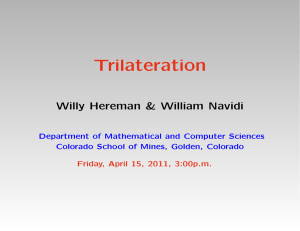

![5.5 The Haar basis is Unconditional in L [0, 1], 1 < 1](http://s2.studylib.net/store/data/010396305_1-450d5558097f626a0645448301e2bb4e-300x300.png)

